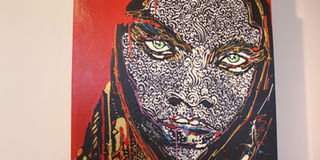A touch of Morocco in works of art

The works of art by Kenyan-based Moroccan artist Adil Roufi. Roufi considers himself an African albeit a North African who has travelled and shown his art all over the world, but claims he never wants to live anywhere else but in this region. Photo/MARGARETTA WA GACHERU
What you need to know:
- He not only speaks the language, but also writes and reconfigures into amazingly intricate arabesque abstract and figurative works of fine art.
- Beside Arabic, cosmopolitan Roufi speaks Spanish, French, English and Kiswahili, among others.
- The calligraphy was all in Arabic, drawn mainly in the so-called Maghrib style, which Roufi says is unique to North Africa.
Adil Roufi is in love with his culture, and especially with his mother tongue, Arabic.
He not only speaks the language, but also writes and reconfigures into amazingly intricate arabesque abstract and figurative works of fine art.
The Moroccan artist is originally from Casablanca but has been painting in Kenya for the last four years.
At Shifteye Gallery over the past fortnight, he shared his passion for his culture in a one-man show he called ‘Arabian Calligraphy.’
Roufi considers himself an African albeit a North African who has travelled and shown his art all over the world, but claims he never wants to live anywhere else but in this region.
Beside Arabic, cosmopolitan Roufi speaks Spanish, French, English and Kiswahili, among others.
This is the first solo show where Roufi focused on presenting the beauty of calligraphy.
All scripted in Arabic, the exhibition fell into two sets.
The first included a small bevy of beautiful women painted in acrylic and oils wherein calligraphic letters could be found everywhere from the beauties’ foreheads to their feet.
In the second, which I found far more interesting, he employed various styles of calligraphic writing that seemed to simulate ancient Arabic texts.
Only one of these unusual artworks quoted from the Koran.
The rest mainly reflected Roufi’s passion for poetry, particularly that of 11th century Persian philosopher, mathematician and poet Omar Khayyam.
And to enhance the arabesque beauty of the writing, he would occasionally draw letters from the Arabic alphabet.
The calligraphy was all in Arabic, drawn mainly in the so-called Maghrib style, which Roufi says is unique to North Africa.
But there are various styles of calligraphy developed over centuries that are used specifically to write in Arabic.
Roufi uses a number of them in his art, including the Kefic and Bismallah styles.
However, one can only see these rarefied distinctions in the drawing by looking closely since they are all interwoven into delicate and detailed arabesque designs.
To simulate the effect of antiquity, Roufi has done a slow burn on the edges of the paper on which he has drawn his calligraphic script works.
The artist also makes practically all of his art materials.
His creates his calligraphic pens out of local bamboo.
He also mixes his own colours using everything from rose petals to saffron spice to coffee grounds and coconut shells.
And instead of painting and drawing on canvas (which he uses when working in acrylic or in oils), he recycles paper sacks, some which previously contained rice or unga flour.
He sometimes will also create using old newspapers.
Roufi loves the idea of being as self-sufficient artistically as possible such that although he’s learned to do sophisticated techniques of digital art and computer illustration at Morocco’s Ecole des Beaux Arts, he also studied other more traditional genres of the visual arts.
What he showcased in Arabian calligraphy is a graphic technique he has developed from childhood.
It is that superlative skill that made his solo show at Shifteye such a special event in the new gallery’s April calendar.
Roufi’s art at Shifteye ranged from Sh15,000 to Sh90,000 with his abstract works on paper being the less expensive, ranging from Sh15,000 to Sh45,000.
Roufi’s artwork can be found in his studio in Hurlingham at Kuona Trust, even though he might be away as he occasionally is commissioned to create intricate mosaics in local temples and mosques.




